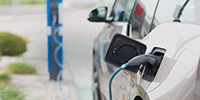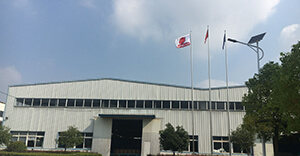What is a lead acid AGM battery
Q.What is a AGM battery?
A.The newer type of sealed Non-spillable maintenance free valve regulated battery uses "Absorbed Glass Mats", or AGM separators between the plates. This is a very fine fiber Boron-Silicate glass mat. These type of batteries have all the advantages of gelled, but can take much more abuse. These are also called "starved electrolyte. Just like the Gel batteries, the AGM Battery will not leak acid if broken.
Q.What is the advantages and disadvantages of lead-acid batteries?
A. Advantage: low price: the price of lead acid batteries is just 1/4~1/6 of that of other types of batteries with a lower investment which most users could bear.
Disadvantage: heavy and bulk, low specific energy, strict on charging and discharging.
Q .Are lead acid batteries recyclable?
A. Lead acid batteries are 100% recyclable. Lead is the most recycled metal in the world today. The plastic containers and covers of old batteries are neutralized, reground and used to the manufacture of new battery cases. The electrolyte can be processed for recycled waste water uses. In some cases, the electrolyte is cleaned and reprocessed and sold as battery grade electrolyte. In other instances, the sulfate content is removed as Ammonia Sulfate and used in fertilizers. The separators are often used as a fuel source for the recycling process.
Q .What is battery rating?
A.The most common battery rating is the AMP-HOUR RATING. This is a unit of measurement for battery capacity, obtained by multiplying a current flow in amperes by the time in hours of discharge. (Example: A battery which delivers 5 amperes for 20 hours delivers 5 amperes times 20 hours, or 100 ampere-hours.)
Manufacturers use different discharge periods to yield an different Amp-Hr. Rating for the same capacity batteries, therefore, the Amp-Hr. Rating has little significance unless qualified by the number of hours the battery is discharged. For this reason Amp-Hour Ratings are only a general method of evaluating a battery's capacity for selection purposes. The quality of internal components and technical construction within the battery will generate different desired characteristics without effecting its Amp-Hour Rating. For instance, there are 150 Amp-Hour batteries that will not support an electrical load overnight and if called upon to do so repetitively, will fail early in their life. Conversely, there are 150 Amp-Hour batteries that will operate an electrical load for several days before needing recharging and will do so for years. The following ratings must be examined in order to evaluate and select the proper battery for a specific application: COLD CRANKING AMPERAGE and RESERVE CAPACITY are ratings used by the industry to simplify battery selection.
Q . What is battery cycle life?
A. One cycle of a battery is a discharge from full charge to full discharge and a return to full charge again. The total number of cycles a battery can perform before failure is called its Cycle Life. Moat battery manufacturers will not discus the Cycle Life of their product. Many advertised Deep Cycle batteries have not been tested, or, which is the case with cranking batteries, were never designed for long Cycle Life .
Q.What is discharge efficiency?
A:Discharge efficiency refers to the ratio of actual power to nominal capacity when battery discharges at the ending voltage in certain discharge conditions. It is mainly affected by factors such as discharge rate, environmental temperature, internal resistance. Generally, the higher the rate of discharge is, the lower the discharge efficiency will be; the lower the temperature is, the lower the discharge efficiency will be.
Q .Does over-discharging damage batteries?
A.OVERDISCHARGING is a problem which originates from insufficient battery capacity causing the batteries to be overworked.
Discharges deeper than 50% (in reality well below 12.0 Volts or 1.200 Specific Gravity) significantly shorten the Cycle Life of a battery without increasing the usable depth of cycle. Infrequent or inadequate recharging can also cause over discharging symptoms called SULFATION. Despite that charging equipment is regulating back properly, over discharging symptoms are displayed as loss of battery capacity and lower than normal specific gravity. Sulfate occurs when sulfur from the electrolyte combines with the lead on the plates and forms lead-sulfate. Once this condition becomes occurs, marine battery chargers will not remove the hardened sulfate. Sulfate can usually be removed by a proper desulfation or equalization charge with external manual battery chargers. To accomplish this task, the flooded plate batteries must be charged at 6 to 10 amps. at 2.4 to 2.5 volts per cell until all cells are gassing freely and their specific gravity returns to their full charge concentration. Sealed AGM batteries should be brought to 2.35 volts per cell and then discharged to 1.75 volts per cell and then this process must be repeated until the capacity returns to the battery. Gel batteries may not recover. In most cases, the battery may be returned to complete its service life. CHARGING Alternators and float battery chargers including regulated photo voltaic chargers have automatic controls which taper the charge rate as the batteries come up in charge. It should be noted that a decrease to a few amperes while charging does not mean that the batteries have been fully charged. Battery chargers are of three types. There is the manual type, the trickle type, and the automatic switcher type.
Q .How to keep the consistency of the battery pack.
A.Though there is a strict battery selection procedure, after a certain period usage, the non-homogeneity will appear more and more obviously.
Meanwhile, charging equipment can’t choose and recongnize the weak battery out, so it is user who can take control of how to keep the equilibrium of battery capacity. User would better test the OCV of every battery regularly or irregularly in the middle and later period of battery pack usage and recharge the battery of lower voltage separately, in order to make the voltage and capacity as the same as other batteries, that decrease the difference between the batteries.
Q .How can I evaluate the health and charge state of a battery?
A. Routine battery examinations detects irregularities in the charging system as well as in the batteries. The principle method is to examine
the electrochemistry of the battery through hydrometric electrolyte inspection. As previously discussed, this important examination cannot be accomplished with sealed absorption or gel batteries. Voltage readings alone require experience to interpret. Hydrometric readings will uncover early warnings of overcharging or over discharging before batteries are damaged. The state-of-charge and reliability of a lead acid battery can best be determined by the specific gravity of the electrolyte measured directly with a common bulb-type hydrometer with a glass float. We do not recommend the ball float type hydrometer. Specific gravity is a unit of measurement for determining the sulfuric acid content of the electrolyte. The recommended fully charged specific gravity of marine batteries is 1.255 to 1.265 taken at 80ĄăC More than .025 spread in readings between fully charged cells indicates that the battery may need an equalization charge. If this condition persists, the cell is failing and the battery should be replaced. Since water has a value of 1.000, electrolyte with a specific gravity of 1.260 means it is 1.260 times heavier than pure water while pure concentrated sulfuric acid has a specific gravity of 1.835.
Q. What is the harm of battery heating?
A. The battery in the charging and discharging process, will release certain heat. But a lot of heats is very harmful to the battery. Heating will
make electrolyte water evaporation and dried up at first, and then gradually reduce the charging efficiency, deform plate, increase resistance, make the mechanical components oxidation, burn out plates or clapboard, finally reducing battery capacity and shortening battery life.
Q. The reasons of battery heating.
A. During the battery charging process, electrical energy transforms into chemical energy, heat energy and other energy. It is normal
phenomenon for that battery is heating during charging. But at high temperature, battery should be timely check whether charge current is too excessive or internal short circuit happens and so on. And, if there are less electrolyte, the internal resistance will increase, which also can cause the high temperature and high voltage when battery is charging. Aging battery, dry electrolyte, internal short circuit, etc. will cause heating as well. If charging equipment can't keep invariable at the later charging period, the voltage value will exceed permission value, and the temperature will raise at the same time. Finally, the battery will be bulged seriously and at the end of its life.
Try not to mean or upend the battery which is in use, for avoiding that lots of gas produced in the battery can’t exhaust from the valve smoothly, especially don’t do it when charging, or this activity will cause cover bombing.
Q .What determines the life of VRLA battery?
A. Sealed lead acid battery life is determined by many factors. These include temperature, depth and rate of discharge, and the number of
charges and discharges (called cycles).
What is the difference between float and cycle applications?
A float application requires the battery to be on constant charge with an occasional discharge. Cycle applications charge and discharge the battery on a regular basis.
Q. What is the storage life of VRLA battery?
A. All sealed lead acid batteries self-discharge. If the capacity loss due to self-discharge is not compensated for by recharging, the battery
capacity may become unrecoverable. Temperature also plays a role in determining the shelf life of a battery. Batteries are best stored at 20℃. When batteries are stored in areas where the ambient temperature varies, self-discharge can be greatly increased. Check the batteries every three months or so and charge if necessary.














